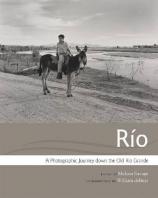Río: A Photographic Journey Down the Old Río Grande
Review
Río: A Photographic Journey Down the Old Río Grande
Beginning up in the snowfields of the southwestern Colorado mountains, snaking through New Mexico to Texas, finally emptying into the Gulf of Mexico after the storied "big bend," the Río Grande has come to occupy a significant place in the thinking of many Americans, both citizens and newly arrived immigrants.
The editor of RIO, Melissa Savage, is a geographer and conservationist who was first drawn to the river by a wish to conserve the natural beauty of the groves of cottonwoods that grew along its banks. She was then attracted to the stunning black and white photographs of the river and region taken by Laura Gilpin. The photos, also including the work of Ansel Adams, Wilfred Dudley Smithers and William Henry Jackson, grace the large pages of this vintage-style picture/prose tribute to the power, beauty and utility of the waterway. Some of the pictures are “unattributed,” like an evocative portrait of two native women filling large earthenware pots with water near San Juan Pueblo in the early years of the 20th century.
"Divided into prose essays with accompanying pictures, Savage’s collection looks at the river in terms of Crossings, Trade, Cultivation, Los Insurrectos, Big Bend and River’s End. Each contributor brings special expertise to his or her subject."
Divided into prose essays with accompanying pictures, Savage’s collection looks at the river in terms of Crossings, Trade, Cultivation, Los Insurrectos, Big Bend and River’s End. Each contributor brings special expertise to his or her subject. Juan Estevan Arellano, who writes about trade, has lived his entire life on the river, his family having long enjoyed the benefits of the river’s agricultural and commercial potential. Jan Reid has studied the unique contours of the river at Big Bend, and in his introduction, historian William DeBuys shows how the development of photography mirrored the development of the river, its industrialization, bridges, railroads, towns and cities.
The photographs speak a mystical language. The International Bridge between Brownsville and Matamoros, designed to swing open for steamships, was completed just as steamship travel was coming to an end, so the swing mechanism was tested once and never used. During the period of Los Insurrectos, a remarkable panorama unfolded as US residents of El Paso --- ladies with parasols and men in suits and hats --- strolled along the Río Grande to watch war in progress on the Mexican side. An old crossing point of river and rail in the lonely desert, beside which a local woman opened a little-patronized tearoom, would become a unique access to Los Alamos for workers at the Manhattan Project. During Prohibition, men smuggled bottles of sotol, whiskey made from an indigenous desert plant, in purpose-made sacks under their coats; a photograph shows two smugglers being caught in the US, but, we are told, such captures were a rare occurrence. The topography of Big Bend, with its thousand-foot-deep Santa Elena Canyon and its perilous rapids, contrasts with a vista of the quiet Mexican village of Boquillas near the bend, waiting as a dust storm looms on the far horizon.
As one of the writers in this photographic essay collection opines, once there was an official border between the US and Mexico, and given the disparities in their economies, it was inevitable that there would be both tourism and trafficking, the latter including the trafficking of human beings “seeking a better life.”
Southwestern writer Dan Flores reminds us in "River's End" that rivers are "one of our connections to the tangible, organic world." With this photographic legacy, we are able to ponder that connection, and with this particular river, to contemplate the subtle intricacies of a border river that both links and divides us.
Reviewed by Barbara Bamberger Scott on December 9, 2016
Río: A Photographic Journey Down the Old Río Grande
- Publication Date: October 15, 2016
- Genres: History, Nonfiction, Photography
- Paperback: 144 pages
- Publisher: University of New Mexico Press
- ISBN-10: 0826356893
- ISBN-13: 9780826356895



